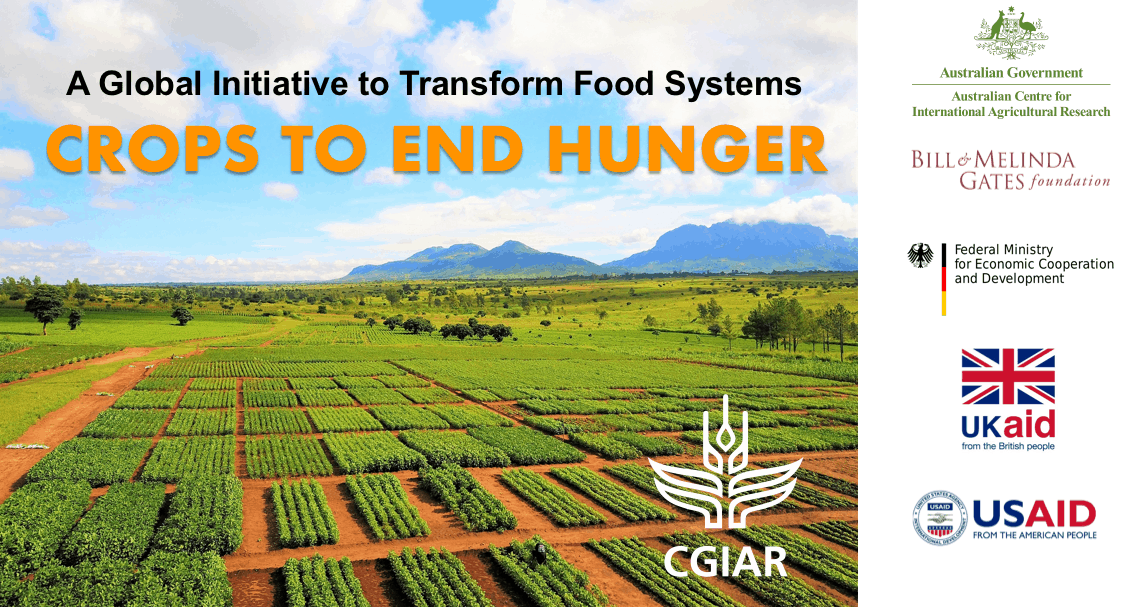
WHAT IS CtEH?
Increasing food demand, pests, diseases and new environmental challenges linked to climate change are requiring more of crop breeding programs. Crops to End Hunger (CtEH) is a multi-Funder CGIAR consortium that aims to accelerate and modernize the development, delivery and widescale use of a steady stream of new crop varieties. These new varieties are developed to meet the food, nutrition and income needs of producers and consumers in Africa and other vulnerable regions.
CtEH supports focused, science-based, long-term CGIAR programs and investments in modern plant breeding on priority crops, which build on:
-
CGIAR’s demonstrated impact on food security and poverty reduction through plant breeding;
-
CGIAR’s comparative advantages in global public goods research on crop breeding and genetics;
-
CGIAR’s central role and responsibility for the conservation and characterization of the world’s crop biodiversity, which is held in trust by CGIAR Research Centers for the world community.
CtEH delivers this through targeted program improvement grants to CGIAR centers and national breeding programs. They also play a vital strategic advisory role that guides CGIAR breeding efforts.
CtEH PROJECTS:
In 2022, Germany’s Federal Ministry for Economic Cooperation and Development (BMZ), through Deutsche Gesellschaft für Internationale Zusammenarbeit (GIZ) announced a funding call worth up to $15 Million USD to fund one-off investments that are necessary to modernize CGIAR-NARES breeding networks. There are now 16 approved CtEH investments, with 14 from this call joining two existing projects. Visit Call for CGIAR Breeding Modernization Proposals for information on GIZ's call. Project fact sheets and other information are below:
- CtEH - Project Fact Sheet: Facilities Upgrade and Mechanization Improvement project
SIX REQUESTS:
CtEH’s overall objective is to modernize CGIAR breeding programs and networks to ensure that they deliver the highest possible rate of genetic gains in farmers’ fields, in the form of nutritious, climate-resilient, market-demanded cultivars. To this end, the Funders and One CGIAR have six specific requests for Centers:
-
Develop pipeline investment cases
-
Incentivize management and staff to deliver higher genetic gain
-
Develop strategic plans for delivery to farmers and varietal turnover
-
Quantitatively optimize pipelines to increase genetic gain
-
Implement shared services
-
Build national agricultural research systems (NARS) breeding networks and capacity
(Download: PDF version of the Six Requests from CtEH Funders)
CtEH FUNDERS:
CtEH launched in 2018-19, bringing together a multi-Funder consortium, with the largest contributions from the German Federal Ministry for Economic Cooperation and Development (BMZ), implemented by the German Agency for International Cooperation (GIZ); along with support from the United States Agency for International Development (USAID), the Bill & Melinda Gates Foundation (BMGF), the UK Department for International Development (DFID), and the Australian Centre for International Agricultural Research (ACIAR). CtEH aims to invigorate breeding for the staple crops most important to smallholder farmers and poor consumers.
ROLE OF CGIAR INITIATIVES AND EIB:
In 2018, when the major funders of the CGIAR launched the Crops to End Hunger (CtEH) CGIAR breeding modernization effort, the partners tasked EiB with ensuring realization of its full potential. To support CtEH, EiB (and now CGIAR Accelerated Breeding and Breeding Resources Initiatives) are:
-
Coordinating and facilitating improvements to meet the Six Requests
-
Overseeing and facilitating subgrants with targeted Centers/NARS to overcome barriers in implementing their improvement plans
-
Facilitating shared, system-wide breeding support services
-
Linking to external contributors such as private sector or research institutions
EiB was given the responsibility for breeding program modernization across the system, adding an implementation and accountability function to the capacity building and coordination roles it was initially designed to perform.
PRIORITY CROPS:
Breeding improvement depends on prioritization of crops by specific geographies based on projected impacts on poverty reduction and nutrition. CtEH prioritizes its investments in crops where data analyses show they have the most potential for impacts on farmer livelihoods and food security. As at July 2022, these include:

BACKGROUND:
With food demand expected to double in low-income countries by 2050, the world needs to produce more and better food. And with escalating climate change and ecological degradation crises, developing the right crop varieties is vital. If we are to reduce poverty and improve nutrition in a climate-challenged world, crop breeding must lead the way.
Credited with spurring the Green Revolution, CGIAR’s crop breeding programs have made major contributions to global food security since the mid-1960s. But there is evidence that the rate of adoption of much needed new varieties has slowed. Breeding programs need to accelerate breeding cycles and apply modern breeding methods to significantly boost both productivity and climate change adaptation.
To reach these goals, CtEH enables Excellence in Breeding to support CGIAR and NARS breeding networks to deliver higher rates of genetic gain and varietal turnover. To do so, they must modernize and optimize their programs through developing product profiles, quantitatively optimize their pipelines, access centralized genotyping services, improve their breeding operations, and use the best breeding informatics tools to make decisions. With this transformation, CGIAR and NARS breeding programs will be ready to meet the food and income security challenges of our modern world.
RELATED RESOURCES:
-
CtEH Project fact sheets and info: see above
- Crops to End Hunger: Call for CGIAR Breeding Modernization Proposals
- GIZ CtEH info sheet
-
White Paper: Accelerating The Delivery of Quality Seed From Breeding Investments Made by CtEH Through Economically Sustainable Seed Systems (PDF)
